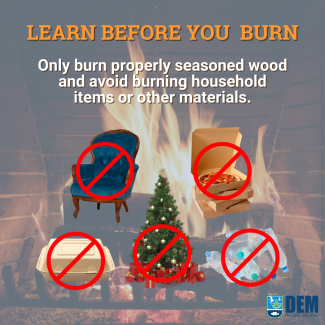Residential Wood Heaters
Fire Pit and Campfire Information - Learn Before You Burn
Wood Heaters & Stoves and Air Pollution
EPA Final Rule
On February 3, 2015, the federal Environmental Protection Agency issued final New Source Performance Standards (NSPS) for Residential Wood Heaters. The standards govern the manufacture, sale, and operation of new residential wood heating devices including single burn-rate and adjustable burn-rate wood stoves, pellet stoves and furnaces, outdoor and indoor wood boilers, and indoor wood-burning forced air furnaces.
Resources
Clean Burning Wood Heaters and Stoves Minimize Health Risks
Background
Some Rhode Island households use wood as a primary heating fuel, while other households use wood stoves and fireplaces as supplementary heating sources. For many people, the sight and smell of wood smoke curling out of a chimney brings back fond memories of hearth and home. Wood is a renewable resource, unlike fossil fuels such as oil, coal and gas, which are non-renewable. In fact, if firewood is harvested in a sustainable way, woodlots can provide an abundant source of fuel for years to come. Unfortunately, smoke from wood burning stoves and fireplaces can be a significant source of air pollution, negatively impacting public health and the environment. People can reduce the amount of smoke from their wood stoves by choosing low-emission EPA-certified stoves, operating them properly, and using seasoned firewood. This will improve combustion efficiency, reduce emissions, help protect public health and the environment, and save fuel costs.
Wood Smoke Concerns
Wood smoke contains fine particle matter, carbon monoxide and other organic compounds, such as formaldehyde, benzene and aromatic hydrocarbons, which form from incomplete combustion. Breathing air containing wood smoke can cause many serious respiratory and cardiovascular health problems. Those at greatest health risk from wood smoke include infants, children, pregnant women, the elderly, and those suffering from allergies, asthma, bronchitis, emphysema, pneumonia, or any other heart or lung disease. The fine particulates of wood smoke, ten microns or less in diameter (a human hair is approximately 70 microns in diameter), can be inhaled deep into the lungs, collect in tiny air sacs (called alveoli) where oxygen enters the blood, and cause breathing difficulties and sometimes permanent lung damage. Inhalation of fine particulate matter can increase cardiovascular problems, irritate lungs and eyes, trigger headaches and allergic reactions, and worsen respiratory diseases such as asthma, emphysema, and bronchitis, which could result in premature deaths. Wood smoke is a particular concern in the winter, when cold, stagnant air and temperature inversions limit air movement. Smoldering fires and short chimneys may cause heavy smoke to stay close to the ground that can cause a neighborhood nuisance and an adverse impact on public health and the environment. Pollutants are trapped and concentrated near the ground, and the small size of the particles allows them to seep into houses through closed doors and windows. Fortunately, recent advances in wood heater design have resulted in the manufacturing of cleaner-burning wood and pellet stoves. The use of these cleaner-burning stoves, in conjunction with proper operation, can reduce the adverse health and environmental impacts associated with using these devices.
Making Smart Home Energy Choices
When making energy choices, the first thing to do is to make sure that your home or building is tight and well insulated. Then evaluate the different home heating options and make a choice that suits your lifestyle and needs.
What should I burn in my stove or fireplace?
You should only burn well-seasoned wood with less than 20% moisture content. Both hardwood and softwood will work well if the moisture content is low enough. If you are unsure of the moisture content, or if you are drying your own wood, you can use a moisture meter to check. Moisture meters are not expensive, and their cost is offset by burning drier wood which burns more efficiently.
There are a few things to consider when choosing wood to burn in your home:
- Avoid woods high in sap, as these do not burn well.
- Hardwoods tend to burn hotter and burn for longer.
- Softwoods also burn hot, but they do burn out slightly faster and are less expensive.
- Make sure all wood you burn is seasoned with less than a 20% moisture content.

For more information from EPA on wood burning and controlling air pollution from residential heaters please look at the EPA Burn Wise Program and the EPA website on Controlling Air Pollution from these heaters.

Why Regulate Outdoor Wood Boilers?
Emissions from outdoor wood boilers can sometimes cause air pollution problems when not sited, installed or operated properly. State regulations have addressed these concerns by implementing strategies to reduce emissions along with siting requirements for new OWBs and operational practices for both existing and new outdoor wood boilers.
Reporting Complaints and Problems from Wood Burning Boilers
The Department is aware that some of the outdoor boilers can cause air quality problems in their neighborhood. Some existing boilers do not have the benefit of recent cleaner design changes that better reduce the particulate matter and hydrocarbons in their exhaust; some have been sited too close to residential buildings and may also not have adequate stack height to disperse their exhaust.
Persons that have complaints about an outdoor wood boiler can report them by calling RIDEM (401) 537-4533.
Choosing a Cleaner Burning Outdoor Wood Boiler
Since Rhode Island allows the use of outdoor wood boilers year-round, check the EPA website EPA Choosing the Right Hydronic Heater.
Local City and Town Regulations
Nothing in the state regulation limits the authority of a city or town to adopt and enforce many ordinances and/or regulations relative to outdoor wood boilers, including but not limited to provisions relative to operation, setbacks and stack heights, prohibiting the installation of outdoor wood boilers, or requiring the installation of lower emitting versions of outdoor wood boilers.
Uncertified Outdoor Wood Boilers
Outdoor wood boilers which have not been tested and approved by the EPA Outdoor Wood-fired Hydronic Heater Program cannot be imported, sold or installed in Rhode Island after July 1, 2011.
The Federal Environmental Protection Agency (EPA) has issued New Source Performance Standards (NSPS) for Residential Wood Heaters to govern the manufacture, sale, and operation of new residential wood heating devices. This includes single burn-rate and adjustable burn-rate wood stoves, pellet stoves and furnaces, outdoor and indoor wood boilers, and indoor wood-burning forced air furnaces. For more information, see the fact sheets below.
FAQ Woodburning – What is Safe to Burn?
Paper, magazines, wrapping paper, pizza boxes, cereal boxes, and printed cardboard at some point will have been treated with a variety of inks, dyes, and coatings and can contain glues. Many of these boxes also have water-resistant coatings. If we burn them, they can release toxic gases into our homes and the atmosphere. Burning these materials is harmful to our families, our neighbors nearby, and the environment.
Any material that has been painted or coated with any finish or chemicals is likely to release a variety of toxic chemicals when burned. These chemicals can be dangerous to you and your family as well as releasing toxic emissions into your neighborhood.
If you watch old painted furniture burn, you’ll see the paint or finish bubble, and many times it smells awful. Even though paints today contain no lead, these paints and coatings can still be toxic when burned. It is particularly important to remember that older furniture was painted with lead-containing paints or finished with stains and coatings that contained toxic materials. Painted or treated wood can also damage your stove, increase maintenance costs, and reduce your stove’s efficiency.
It is NEVER safe to burn pressure-treated wood!!
Pressure-treated wood is treated with chemicals to make it safe from insects and fungus. These chemicals can include arsenic, copper and chromium so they are released into the air when you burn the pressure-treated wood, they are very toxic for you and your family to breathe. These chemicals are not just toxic to breathe, but they can contaminate the environment by contaminating the soil.
As tempting as it is to burn your Christmas tree you should NOT burn it in your stove or fireplace! You should never use wood from Christmas trees in your stove because not only is it likely to have a significant level of moisture but it most likely was treated with chemicals and preservatives. Burning these trees can release toxic fumes into your home and the environment. In addition, the evergreen woods contain a high level of resins which can burn quickly and can pop which can increase the risk of a chimney fire.
It is not safe to burn plywood or particleboard as fuel in your wood-burning stove or fireplace. Many wood products for building and furniture today are plywood or particleboard. Many of these supplies and products have been treated with an array of chemicals, glues, coatings and resins. Like many other treated materials, when burned, plywood, and particleboard are likely to release toxic fumes. In addition, these materials produce a lot of ash which can lead to reduced stove efficiency since your stove may clog, this can also increase your risk of a fire.
Maybe you have some leftover water bottles, bubble-wrap from your online ordering or some plastic partyware and want to use these to start a fire in your stove or fireplace. But burning even a small amount of household plastics can release toxic chemicals such as hydrochloric acid, sulphur dioxide, heavy metals and dioxins which are very dangerous to your health and to the environment. Do not burn plastics in your stove or fireplace!!
For many campers and beach goers the advice to not burn driftwood is surprising! But driftwood can have moisture at its core and may contain a level of salt. When burned, salt particles are very corrosive and can cause damage to your stove, fireplace and flue.
It’s important never to burn trash in your wood stove or fireplace! Household waste can release toxins and chemicals into the air, which poses a risk to you and your family’s health as well as the surrounding environment. Trash does not burn cleanly, it produces toxic smoke, and can dirty or damage your stove or fireplace, it can also cause clogs and blockages and increase the risk of fires in your chimney.
